List of brackish aquarium fish species
This is a list of commonly seen fish that can be kept in a brackish water aquarium.
Cyprinidontiformes
| Poeciliids |
| Common name | taxonomy | Picture | Max size | Tank Type | Description | Temperature Range | pH range | Water Hardness | Salinity |
|---|---|---|---|---|---|---|---|---|---|
| Guppy | Poecilia reticulata | 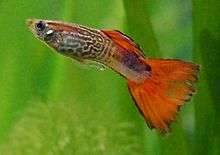 | Community | Many color and tail pattern varieties exist, also can tolerate above ocean level salt. Normally freshwater. | |||||
| Black molly | Poecilia sphenops | Community | |||||||
| Sailfin molly | Poecilia latipinna | 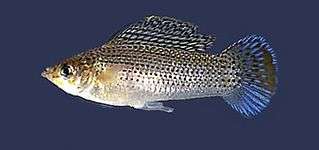 | Community | Gold and silver varieties commonly found. | |||||
| Other |
| Common name | Taxonomy | Picture | Max size | Tank Type | Description | Temperature Range | pH range | Water Hardness | Salinity |
|---|---|---|---|---|---|---|---|---|---|
| Four-eyed fish | Anableps spp. | 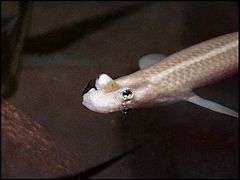 | 12" | These fish can see above and below water. | |||||
| American Flagfish | Jordanella floridae |  | Community | May eat hair algae, but also may eat plants. | |||||
Catfish
| Common name | Taxonomy | Picture | Size | Tank Type | Remarks | Temperature range | pH range | Water hardness | Salinity |
|---|---|---|---|---|---|---|---|---|---|
| Sea catfish | |||||||||
| Colombian shark catfish | Hexanematichthys seemanni | ||||||||
| Australian shark catfish | Arius graeffei | ||||||||
| Berney's shark catfish | Arius berneyi | ||||||||
Pufferfish
| Common name | Taxonomy | Picture | Size | Tank Type | Remarks | Temperature range | pH range | Water hardness | Salinity |
|---|---|---|---|---|---|---|---|---|---|
| Common Toadfish, Toado | Tetractenos hamiltoni | 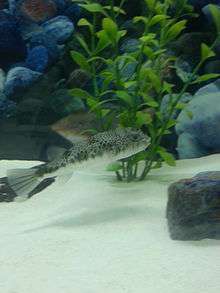 | 4" | Species tank or with other fish too large to bully. | Rarely seen in the aquarium trade, even in Australia, where it is native. Adaptable to a wide range of conditions and habitats, from marginal, polluted freshwater-brackish creeks to fully marine seagrass flats, as long as the habitat is sheltered from strong currents. | ||||
| Figure 8 pufferfish | Tetraodon biocellatus |  | 4" | Best kept as species only | Requires brackish aquarium conditions with very low Nitrite and Nitrate levels to be kept successfully. Freshwater compromises immune system, harms puffer, and shortens life extremely. Commonly kept in freshwater. | ||||
| Green spotted puffer | Tetraodon nigroviridis |  | 6" | Best kept as species only | Often sold as freshwater fish, but this species actually thrives in brackish water. As the fish matures, it requires the salinity levels to slowly increase with age. Must be kept in aquarium with very low Nitrite and Nitrate levels to be kept successfully. A highly varied diet is a necessary requirement for this species. Prawns, muscle meat, mysid, squid and aquatic snails are all relished. Provide Shelled food to naturally trim the puffers constantly growing teeth. | 1.008-1.018 | |||
Gobies
| Common name | Taxonomy | Picture | Size | Tank Type | Remarks | Temperature range | pH range | Water hardness | Salinity |
|---|---|---|---|---|---|---|---|---|---|
| Bumblebee goby | Brachygobius xanthozonus | 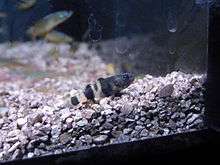 | 1.5" | Community or Species Only | Often a picky eater. Will accept thawed frozen brine shrimp or mysis shrimp. Can be outcompeted for food by more aggressive fish. | ||||
| Water Cow | Eleotris picta | 17" | |||||||
| Violet goby, Dragon goby | Gobioides broussonnetii |  | 21" | Brackish community tank | Though pet stores often label as "vicious" this fish is actually quite harmless | ||||
| Mudskipper (Barred Mudskipper) | Periophthalmus argentilineatus | 6" | This fish requires "land" to crawl out of the water. | ||||||
| Mudskipper (Atlantic Mudskipper) | Periophthalmus barbarus | 9" | This fish requires "land" to crawl out of the water. | ||||||
| Knight goby | Stigmatogobius sadanundio | 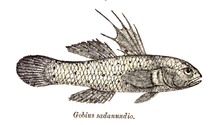 | 3.5" | ||||||
Cichlids
| Common name | Taxonomy | Picture | Size | Tank Type | Remarks | Temperature range | pH range | Water hardness | Salinity |
|---|---|---|---|---|---|---|---|---|---|
| Cichlids | |||||||||
| Blackchin tilapia | Sarotherodon melanotheron melanotheron | 11" | |||||||
| Orange chromide | Etroplus maculatus | 3" | |||||||
| Green chromide | Etroplus suratensis | 15" | |||||||
| Mayan cichlid or Mexican mojarra | Mayaheros urophthalmus | 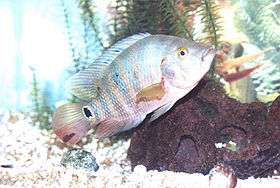 | 39.4 cm | 28 - 33 degrees Celsius | 0 - 40 ppt | ||||
Other fish
| Common name | Taxonomy | Picture | Size | Tank Type | Remarks | Temperature range | pH range | Water hardness | Salinity |
|---|---|---|---|---|---|---|---|---|---|
| Siamese tigerfish | Datnioides microlepis | 18" | These fish must be kept in large aquaria.[1] | 22–26 °C (72–79 °F) | 7.6–8.0 | ||||
| New Guinea tigerfish | Datnioides campbelli | 13" | Keep with other big fishes that can not fit to its mouth | These fish must be kept in large aquaria.[2] | 22–26 °C (72–79 °F) | 7.6–8.0 | |||
| Silver moony | Monodactylus argenteus | 10" | These fish are also known from marine habitats. | ||||||
| African moony | Monodactylus sebae | 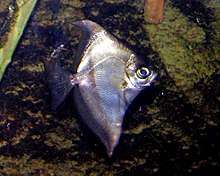 | 10" | These fish are also known from marine habitats. | |||||
| Indian glassy fish | Parambassis ranga | 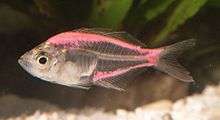 | 3.1" | These fish are often dyed. | |||||
| Targetfish, Jarbua terapon | Terapon jarbua | 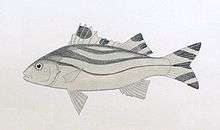 | 14" | These fish breed in saltwater and the young return to freshwater. | |||||
| Banded archerfish | Toxotes jaculatrix | 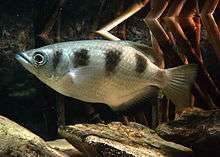 | 12" | These fish have the ability to shoot water to hit their insect prey. | |||||
| Green Scat, Ruby Scat | Scatophagus argus | 15" | Community, especially with Monodactylus sp. (Monos) | A ravenous herbivore that quickly defoliates any aquatic plants in the aquarium. One of the few common brackish water plants in the trade, the Java Fern (Microsorum pteropus) appears to be toxic to these fish and should not be planted with "scats". | |||||
| Hogchoker | Trinectes maculatus | .jpg) | 3" | Often sold under the misnomers "Freshwater Flounder" or "Freshwater Fluke", but is in fact a brackish water fish | |||||
See also
- List of brackish aquarium invertebrate species
- List of brackish aquarium plant species
- List of fish common names
- List of aquarium fish by scientific name
- List of freshwater aquarium fish species
- List of freshwater aquarium plant species
- List of freshwater aquarium amphibian species
- List of marine aquarium fish species
References
| Wikimedia Commons has media related to Brackish aquarium fishes. |
This article is issued from
Wikipedia.
The text is licensed under Creative Commons - Attribution - Sharealike.
Additional terms may apply for the media files.